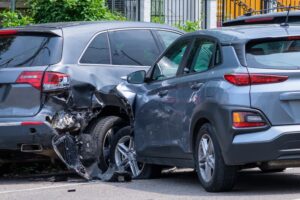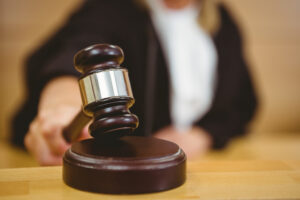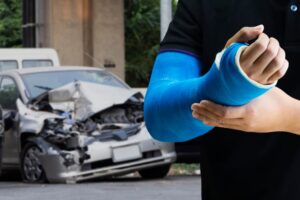Getting into a car accident is a frightening experience, but few crashes are as abrupt and devastating as a T-bone accident. If you’ve been involved in one, you’re likely feeling overwhelmed, confused, and unsure of what to do next. One of the first questions you’ll have on your mind is, “Who is at fault?”
Determining fault is critical, as it can directly impact your ability to receive the financial support and justice you deserve. In most cases, it pays to have an experienced car accident attorney handling your case.
What is a T-Bone Accident?

The nature of a T-bone collision makes it particularly dangerous. Unlike the reinforced structure in the front or rear of a car, the sides usually offer much less protection. When a vehicle strikes another from the side, it’s often the driver or passengers who take the full force of the impact. This can lead to severe injuries or even fatalities, especially when high speeds are involved.
Dangerous Intersections in Cape Girardeau Where T-Bone Car Accidents Are More Likely to Occur
Certain intersections in Cape Girardeau see more accidents than others, often due to high traffic volumes, poor visibility, or complex traffic patterns. T-bone collisions, in particular, are more likely at intersections where drivers must cross or merge into busy roads. Here are some high-risk intersections in Cape Girardeau:
- Mount Auburn Road & William Street (Route K): This intersection experiences heavy traffic throughout the day, particularly during rush hours. Drivers often attempt risky left turns or fail to properly yield, creating a prime environment for side-impact collisions.
- Kingshighway (US 61) & Independence Street: With multiple lanes and consistently high traffic, this is one of the busiest intersections in the city. Distracted or impatient drivers trying to beat the light frequently cause accidents here.
- Cape Rock Drive & Kingshighway (US 61): The volume of left-turning vehicles and merging traffic can make this area a high-risk zone for T-bone accidents. Sudden stops and misjudged turns contribute to the danger.
- Sprigg Street & Broadway Street: This downtown intersection sees a mix of pedestrian and vehicle traffic. Drivers failing to obey stoplights or navigating the intersection unsafely are common causes of side-impact crashes.
These intersections are often hubs of activity due to shopping centers, schools, or major connecting roads. Heavy traffic increases the likelihood of driver impatience, distractions, or confusion with traffic signals—factors that lead to T-bone accidents. Additionally, the layout of some intersections may leave drivers with limited visibility, especially at night or in bad weather.
Common Causes of T-Bone Accidents
Understanding how these accidents happen can provide some clarity about fault and prevention. Many T-bone accidents can be traced to driver error or negligence, and some common causes include:
- Running Red Lights or Stop Signs: One of the most frequent causes of T-bone accidents is when a driver fails to stop at a red light or stop sign. When one vehicle proceeds through an intersection without the right of way, it puts crossing vehicles in immediate danger.
- Failing to Yield: Failure to yield properly, particularly during left turns or at uncontrolled intersections, is another common cause. This can happen when a driver misjudges the speed of oncoming traffic or doesn’t see another car approaching.
- Distracted Driving: Checking a phone, adjusting the radio, or even talking to passengers can take a driver’s attention off the road. A brief moment of distraction can make it easy to miss a traffic signal or crossing vehicle, leading to a T-bone collision.
- Driving Under the Influence: Impaired drivers often have slower reaction times and poor decision-making abilities. Alcohol or drugs can cause them to miss signals or fail to yield when required.
- Poor Weather or Road Conditions: Slippery roads, low visibility, or poorly maintained intersections can increase the likelihood of T-bone accidents as drivers struggle to maintain control or see other vehicles in time.
Determining Fault in a T-Bone Accident
Fault in a T-bone accident can be complicated. While certain scenarios—such as running a red light—might seem straightforward, other factors can make determining fault challenging. Here’s how fault is usually assessed:
- Traffic Laws: Traffic laws are one of the primary tools used to determine fault. For instance, if a driver violated a traffic signal or failed to yield, they might be considered at fault. But keep in mind, both parties could share some degree of responsibility depending on the situation.
- Eyewitness Accounts: Witnesses who saw the accident happen can provide invaluable information. Their statements can help clarify who had the green light or whether a driver seemed distracted or impaired.
- Police Reports: When authorities respond to a T-bone accident, they typically document the scene and interview those involved. The resulting police report often contains preliminary opinions about fault, based on available evidence.
- Accident Reconstruction: Sometimes, experts in accident reconstruction are brought in to analyze crash data, such as skid marks, vehicle positions, and points of impact. Their analysis can paint a clear picture of how the accident occurred.
- Surveillance or Traffic Camera Footage: Surveillance footage or traffic cameras can be crucial in determining fault, especially if the video shows a driver ignoring a red light or other clear violations.
Fault determination can be nuanced. Even if another driver appears clearly responsible, insurance companies or other parties may attempt to dispute the findings.
The Impact of T-Bone Accidents on Victims
Surviving a T-bone accident isn’t just about escaping the crash—it’s about managing the physical, emotional, and financial aftermath. These collisions often leave victims facing a daunting road to recovery.
Physical Injuries
The force of a T-bone collision can cause serious injuries, including:
- Whiplash and neck sprains caused by the sudden jerking motion upon impact
- Broken ribs or other fractures, especially on the side of the body closest to the collision
- Traumatic brain injuries (TBIs), resulting from the head striking the window, door, or other hard surfaces
- Spinal cord injuries, potentially leading to partial or full paralysis
- Internal injuries, such as damage to vital organs or internal bleeding
- Soft tissue injuries, including muscle strains, ligaments tears, and bruising
- Severe lacerations from shattered glass or sharp vehicle components
- Chest injuries, such as bruising or fractures caused by the seatbelt or airbag deployment
- Pelvic and abdominal injuries, particularly if the impact was near the lower part of the vehicle
T-bone accident victims may require lengthy hospital stays, surgeries, or months of physical therapy to regain mobility and heal.
Emotional Trauma
A car accident doesn’t just hurt your body; it can deeply impact your mental and emotional well-being. Many survivors experience anxiety, depression, or post-traumatic stress disorder (PTSD) following an accident. The fear of getting back behind the wheel can linger for months or years.
Financial Burdens
Between medical bills, car repair costs, and lost income from time off work, the financial strain of a T-bone accident can be overwhelming. For families struggling to make ends meet, these expenses can add to an already stressful situation.
Steps to Take in the Days and Weeks After a T-Bone Accident
If you’re reading this after a T-bone accident, you might feel unsure about what to do next. While gathering information at the scene—such as the other driver’s contact and insurance details, photos of the damage, and witness statements—is ideal, not all accidents allow for this, especially if injuries required immediate medical attention. Fortunately, there are steps you can take now to protect your rights and build a strong case.
- Organize and Document: If you have any information from the accident—such as police reports, photos, or notes you took—gather it in one place. If you weren’t able to document the scene, try to write down everything you remember as soon as possible, including the location, weather conditions, and sequence of events.
- Seek Medical Evaluation: Even if you’ve already seen a doctor, follow up on your injuries and keep detailed medical records. Some injuries may not become evident until days later, and having thorough documentation will strengthen your case.
- Reach Out to Witnesses: If you didn’t get witness contact information at the scene, check with the police report or nearby businesses to see if anyone is willing to provide a statement about what they saw.
- Notify Insurance Companies: Report the accident to your insurer, but be cautious about giving detailed statements or accepting settlements before fully understanding your rights. Insurers may try to minimize your claim.
- Speak with a Personal Injury Attorney: A skilled attorney can help uncover evidence you may have missed, such as traffic camera recordings, and negotiate with insurance companies on your behalf. Whether it’s handling legal complexities or securing fair compensation, having an advocate can make all the difference in your recovery process.
Taking these steps now can safeguard your rights and ensure you’re positioned to pursue the justice and compensation you deserve.
The Importance of Legal Representation

- Investigate Your Case: Your attorney will dig into the details—reviewing police reports, consulting accident reconstruction experts, and gathering witness statements to build a strong case for you.
- Handle Insurance Companies: Insurance companies often aim to settle claims quickly and for as little money as possible. A lawyer will negotiate on your behalf to ensure you’re not undercompensated for your injuries or damages.
- Prove Fault: Establishing clear fault is critical to winning your case. With an experienced attorney, you’ll have someone who knows how to interpret traffic laws, use evidence effectively, and counter arguments from the at-fault party.
- Pursue Maximum Compensation: Whether it’s covering medical bills, lost wages, or emotional suffering, your lawyer will fight for every dollar you deserve. They’ll ensure the compensation you receive reflects the true impact the accident has had on your life.
Having the right legal support after a T-bone accident can make a significant difference in your recovery and ability to move forward. A skilled attorney will not only help untangle the complexities of your case but also fight to ensure your rights are protected, and your compensation truly reflects the impact the accident has had on your life.
Seek the Support You Deserve from Cook, Barkett, Ponder & Wolz
T-bone accidents can turn your life upside down, but you don’t have to face this difficult time alone. At Cook, Barkett, Ponder & Wolz, we understand the tremendous challenges you’re going through—physically, emotionally, and financially.
With more than 100 years of combined trial experience, our dedicated personal injury attorneys are here to guide you through the complexities of your case. We’ll work tirelessly to determine fault, hold negligent parties accountable, and recover the compensation you deserve. And with our “no fees unless we win” promise, you can focus on your recovery without worrying about upfront costs.
If you or a loved one has been involved in a T-bone accident in Cape Girardeau, Sikeston, or anywhere in Southeast Missouri, reach out to Cook, Barkett, Ponder & Wolz today. We’ll start with a free case evaluation to learn more about your situation and help you take the first steps toward justice and healing.
You’re not just another case to us—you’re a person with a story worth fighting for. Contact us today at (573) 335-6651 or through our online form to discuss your case during a free case consultation.



